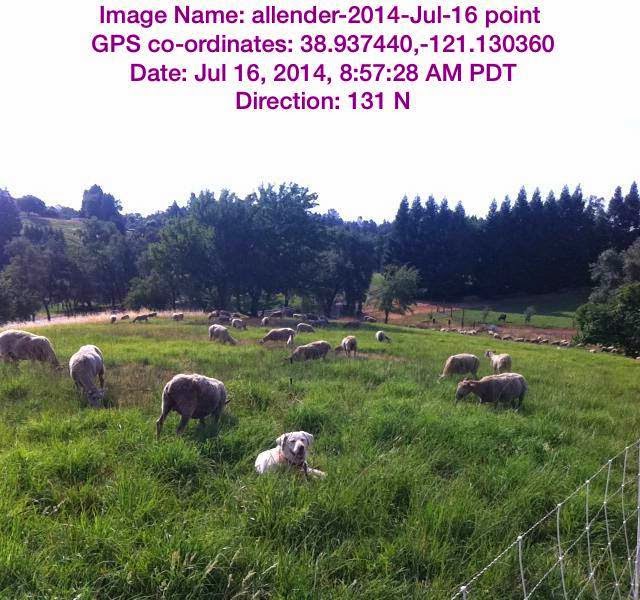 |
| Soldiers in the War on Weeds! |
Perhaps I should pause and provide my favorite non-scientific definition of a weed. A weed is a plant that's growing somewhere that you don't want it to be. When I grew vegetables, the weeds I hated the most were Bermuda grass, Johnson grass and red-root pigweed. By this definition, however, a squash plant in the middle of a row of tomatoes would be a weed, too - it's not wanted there!
Now that we focus exclusively on grass-fed sheep production, we divide our grazing resources into two categories - unirrigated rangeland and irrigated pasture. The weed issues are different in each category. Our rangelands are dominated by annual grasses and forbs that were introduced from Europe and Asia with the arrival of Spanish livestock. I read recently that a severe drought in the 1860's allowed these plants to take hold and push out the native grasses. By the above definition, today's valuable forage species (soft chess, annual ryegrass, rose clover, filaree, etc.) were once weeds - they were growing where they weren't wanted. Today's "weeds" include more recent arrivals - yellow starthistle, medusahead barley, barbed goat grass, bull thistle, milk thistle and skeletonweed (just to name a few). On some of our rangelands, we have undesirable native "weeds," too - like poison oak.
The plants in our irrigated pasture are mostly introduced (or planted) perennial grasses and clovers. Typically, we have orchard grass, ladino clover, dallis grass, birdsfoot trefoil and tall fescue in our higher quality irrigated pastures. Today's weeds include smut grass and broom sedge (Don't you just love the common names of weeds? So much more fun than the Latin names, in my opinion!)
The weeds in both systems can be problematic. Medusahead barley, for example, contains a high amount of silica, which means it doesn't decompose as rapidly in the winter. It creates a thatch which prevents sunlight from reaching the soil surface, and through which only more medusahead can grow. Yellow starthistle has an exceptionally deep taproot that allows it to access soil moisture when most other plants are drying up. Like medusahead, it can create a monoculture that is harmful ecologically and agriculturally. On irrigated pasture, smut grass is a plant that produces a lot of stalk and not much leaf - not ideal for grazing! The stalk is high in cellulose, which makes it less palatable to livestock. Broom sedge is a warm-season grass that grows rapidly in the middle of the summer. Like medusahead and starthistle, it can create a monoculture. With fine hairs on its leaves, it's not especially palatable either.
 |
| Grazing last year's starthistle "skeletons" and this year's sprouts. |
Some of the weeds on our irrigated pastures are a bit more challenging. Since smut grass doesn't have much leaf material, it doesn't provide much forage value. Broom sedge is not terribly palatable, but we have found that our ewes will eat it (while the lambs will not). We are experimenting this year with a different irrigation regime (12-hour sets instead of 24 hours) and with severe grazing on the parts of our pastures with smut grass and broom sedge. On the plus side, broom sedge grows rapidly during the hottest part of the summer - we can regraze broom sedge in 21 days (as opposed to the 35-40 rest periods we allow on other pastures).
Even as we've adapted our grazing strategies to take advantage of what these weeds can provide, we're still focused on shifting our pastures towards a more desirable mix of grass and forbs. We'd love to have more native perennial grasses - some of our pastures have purple needlegrass, for example. These native perennials stay green later in the year and have habitat and soil protection benefits. We are also thinking about trying to plant some dry-season perennials that can survive our long, dry summers without much (if any) irrigation. In some ways, I guess we're trying to balance managing for what we don't want (weeds) with managing for what we do want (desirable plants). I find that there's always something new to learn!
 |
| "Before" - 5 minutes after putting 120 ewes onto a 1.5 acre paddock on irrigated pasture. The green stuff in the foreground is broom sedge. |
 |
| "After" - the same paddock, 3 days later! |
Finally, there are two weeds that I have absolutely abhor as a shepherd. Common cocklebur and spiny clotbur are the most obnoxious (beyond noxious) weeds in our ecosystem. Both can be grazed at the right time of year (even though they are slightly toxic at certain growth stages), but what I hate about them is the seeds they produce. These burs are enormous, and they love clinging to wool and dog hair. They can cause sores on my dogs, and they diminish the value of our wool. And so I have declared war on these weeds - my weapons of choice are a sharp hoe or my own two hands. I'm not sure I can learn to love (or even like) cocklebur and clotbur!
 |
| Common cocklebur - enemy of sheepmen everywhere! |
 |
| Spiny clotbur - have you ever seen a nastier looking plant?! |


No comments:
Post a Comment